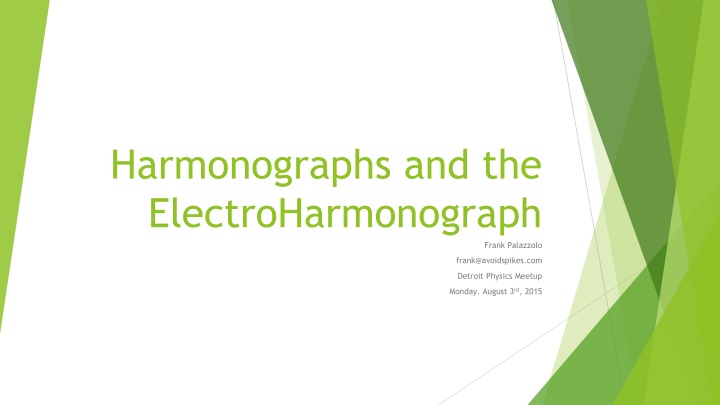Harmonographs and the ElectroHarmonograph
Uncover the fascinating world of harmonographs and the innovative ElectroHarmonograph through a blend of history, physics, math, and engineering. Learn about the origins, workings, and creative possibilities of these intricate machines. Explore the harmonious patterns generated by pendulum motions and delve into the realm of electronic harmonograph simulations. Get inspired by the fusion of art and science in these mesmerizing creations.
Download Presentation

Please find below an Image/Link to download the presentation.
The content on the website is provided AS IS for your information and personal use only. It may not be sold, licensed, or shared on other websites without obtaining consent from the author.If you encounter any issues during the download, it is possible that the publisher has removed the file from their server.
You are allowed to download the files provided on this website for personal or commercial use, subject to the condition that they are used lawfully. All files are the property of their respective owners.
The content on the website is provided AS IS for your information and personal use only. It may not be sold, licensed, or shared on other websites without obtaining consent from the author.
E N D
Presentation Transcript
Harmonographs and the ElectroHarmonograph Frank Palazzolo frank@avoidspikes.com Detroit Physics Meetup Monday. August 3rd, 2015
Something For Everyone History Physics Math Engineering
What is a Harmonograph? 19thCentury Parlor Game Automatic drawing machine, based on the motion of pendulums Patterns are similar to a Spirograph toy Variation in pictures comes from: Different physical parameters (Pendulum Length, etc.) Different initial conditions (Start Position)
Harmonograph Links Book: http://www.amazon.com/s/ref=nb_sb_noss_1?url=sear ch-alias%3Daps&field-keywords=harmonograph Videos: https://www.youtube.com/watch?v=bXAWXoew9mM Samples: https://www.google.com/imghp?hl=en&q=harmonograp h+drawing
How It Works 2-Pendulum and 3-Pendulum varieties Two pendulums control X and Y displacement of a pen Third pendulum (Rotary) controls a movable writing platform.
Whats in a name? Name comes from it s relation to music Simple mathematical relations between pendulum lengths lead to nice symmetric patterns (Harmonies!) just like musical notes Other relations lead to discord / chaotic looking pictures
The ElectroHarmonograph Idea: Could I make an electronic version of a Harmonograph? Electrical circuit could mimic the pendulum motions. Real-time display of the results Knobs to change the Pendulum parameters Already seen simulators, wanted something physical
80s Coin-Operated Arcade Games Big Cabinets Control Panel Cathode-Ray Tube (CRT) Monitors Raster vs Vector Monitors
Cathode Ray Tubes Vacuum tube (Picture Tube) Electron gun (source of electrons) Phosphor-coated screen change electrons into light Magnetic Coils used to deflect electron beam
Color vs Black & White Color Monitor has 3 electron guns Shadow Mask 3 phosphors (Red, Green, Blue)
Raster Monitor (Old TV tech) Horizontal and Vertical Deflection is fixed Screen data is painted on top to bottom, left to right Beam is blanked while retracing from bottom to top
Vector Monitor (Special) Beam can directly be control via X and Y voltages. Beam brightness is related to intensity of the beam, and the velocity of the beam Not used for curved lines Very Black background Only popular for a short time late 70 s to mid 80 s Need to Use This!
How to generate the X and Y signals Could use a digital computer board (Raspberry PI, BeagleBoard), with X and Y out (analog voltage out). Mostly a software project. Could build raw circuits which generate the necessary X and Y waveforms (analog) This is basically an Analog Computer
Analog Computers Analog as in not Digital Analog: can take on a range of values (continuous) Digital: can take on a fixed set of values (discrete) Analogue as in analogy or analogous Analog Computers don t compute , they just act Circuit made of Amplifiers and Switches which is the electrical analogue of a pendulum system (acts the same)
Simple (1D) Pendulum Physics Energy transfer from Kinetic to Potential over time Energy decays over time due to friction Energy Equation (Hamiltonian) Kinetic is based on speed Potential is based on position Linear Simplification (small deflection)
Simple (1D) Pendulum Physics contd Equation of Motion Simple Harmonic Oscillator with Damping Direct Solution is possible
Spherical Pendulum (2D) Physics See Paper https://www.physicsforums.com/attachments/deriving -the-eqns-of-motion_second-approach-3d-pdf.47912/ Trig functions Cross terms (x times y)
How To Drive a Vector Monitor 1) Turn Beam Off while moving circuit to initial conditions (Retrace!) 2) Turn Beam On and let the circuit run for a while (Draw!) 3) Repeat! Shouldn t leave the beam in one spot to long will burn hole in the phosphor! Atari Spot killer circuit should help with this
Pendulum circuit building blocks Op-Amps (Operational Amplifiers) Voltage is the independent variable Can act as an integrator, gain, inverter, sum No multiply, complex functions Analog Switch Connect/Disconnect circuits on demand
1D Pendulum Circuit Simple Harmonic Oscillator with Damping 2 Capacitors energy storage devices Kinetic Energy / Speed / Initial Condition Potential Energy / Position / Initial Condition Adjust Voltage for Initial Condition (Position) Adjust Resistor for Frequency (Pendulum Length) Adjust Resistor for Damping (Friction) 3 Op-Amps + 2 Analog Switches, 1 More Op-Amp for Initial Conditions
Rotary Pendulum Circuit Uh-oh too hard to do correctly without Analog Multipliers, at least Wait let s try another 1D oscillator Use Position as X Use Speed as Y Already 90 degrees out of phase Circular Motion at a given frequency Elliptical Motion above or below that frequency Good Enough!
Other Circuit Design Power Regulator 3 Pendulum Oscillators Summers for X and Y Oscillator for Draw/Retrace (Duration Knob) Brightness adjusts Color-Enable Switches
Development Process Repair Game Prototype Rotary Oscillator Build/Debug rest of the circuit Physical Design/Construction and Assembly <2 Months Last wiring error fixed 3:00AM day of Maker Faire!!!
The Result Pretty Dang Cool!!! Some unexpected effects Clipping/Jumping behavior Non-Physical parameter ranges Pendulum too short Friction too low Very 3D-like effects!! More Friction than expected
Next Time? Do A PCB!!! Digital Version??? More Gain? Modulate Colors? Sound? Better handling of control ranges?























